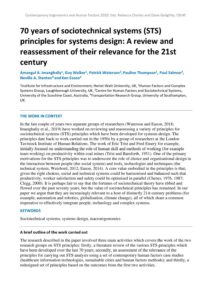| Document | Author Amangul A. Imanghaliy, Guy Walker, Patrick Waterson, Pauline Thompson, Paul Salmon, Neville A. Stanton and Ken Eason |
| Abstract In the last couple of years two separate groups of researchers (Waterson and Eason, 2018; Imanghaliy et al., 2019) have worked on reviewing and reassessing a variety of principles for sociotechnical systems (STS) principles which have been developed for systems design. The principles date back to work carried out in the 1950s by a group of researchers at the London Tavistock Institute of Human Relations. The work of Eric Trist and Fred Emery for example, initially focused on understanding the role of human skill and methods of working (for example team working) on productivity within coal mines (Trist and Bamforth, 1951). One of the primary motivations for the STS principles was to underscore the role of choice and organisational design in the interaction between people (the social system) and tools, technologies and techniques (the technical system; Weisbord, 2012; Eason, 2014). A core value embodied in the principles is that, given the right choices, social and technical systems could be harmonised and balanced such that productivity, worker satisfaction and safety could be optimised in parallel (Cherns, 1976, 1987; Clegg, 2000). It is perhaps fair to say that the fortunes of sociotechnical theory have ebbed and flowed over the past seventy years, but the value of sociotechnical principles has remained. In our paper we argue that they are increasingly relevant to a host of distinctly 21st century problems (for example, automation and robotics, globalisation, climate change), all of which share a common imperative to effectively integrate people, technology and complex systems. |

